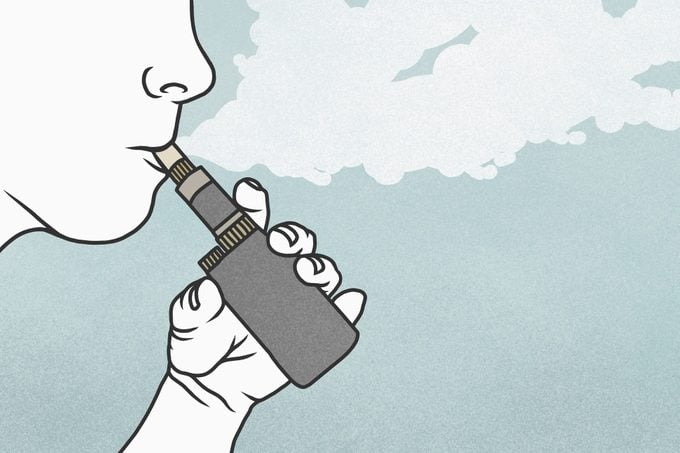Does Vaping Affect Your Bone Health?
Updated: Mar. 14, 2022
As more research emerges about vaping, it's clear that it might not be as safe of a cigarette alternative as manufacturers have promised. A recent study has found that if you vape and smoke, you may be seriously jeopardizing your bones.
Problems with vaping continue to surface
E-cigarette use, commonly known as vaping, has been on the rise in recent years, in part thanks to its being promoted as a safer alternative to cigarette smoking.
However, in 2019 the US Food and Drug Administration (FDA) came down on e-cigarette company Juul for making those claims. The agency questioned the manufacturer for marketing its vape pens as “modified risk tobacco products” because, as experts today emphasize, it’s a controversial claim that research doesn’t yet support.
In fact, evidence is stacking up against the safety of vaping. While it may be the lesser of two evils, emerging data suggests a link between vaping and these risks:
- greater odds of developing asthma and chronic obstructive pulmonary disease (COPD,) according to a study published in the American Journal of Preventive Medicine.
- an increased risk of heart problems, according to the European Journal of Preventive Cardiology.
- a potentially higher cancer risk thanks to vape pens’ cocktail of dangerous chemicals, including acrolein, as reported by the American Lung Association.
Does vaping affect your bones?

A study published in November 2021 points to another possible vaping casualty: our bone health.
The National Institutes of Health (NIH) say that traditional cigarette smoking is a well-established risk factor for osteoporosis. This condition weakens bones and increases the likelihood that they’ll break or fracture.
A team of researchers studied more than 5,500 adult e-cigarette users to understand whether vaping posed a similar risk. Their findings—published in the peer-reviewed American Journal of Medicine Open—suggest electronic cigarette use “may be detrimental to bone health,” even in young people. The study found that people who vape had a 46 percent greater rate of bone fractures than those who did not.
The study also found that people who use both cigarettes and e-cigarettes actually have a greater fracture risk than conventional smokers.
The researchers emphasize that these results don’t prove that vaping causes broken bones, but indicate a potential association.
How does vaping harm bone health?
Purnima Kumar, PhD, a professor of periodontology at The Ohio State University, emphasizes something you’re probably aware of: your lifestyle takes a toll on your wellness and physiology. “Environmental factors like smoking, vaping, alcohol use—they can all modify your health risks,” she says. Things like your genetics, age, diet, level of physical activity, and pre-existing health conditions each have an influence as well.
So, while more research is needed to explore the effects of vaping on our skeleton, there’s substantial evidence behind how cigarette use works to weaken bones. One of the researchers’ leading theories is that vaping acts similarly.
(Looking to reverse years of imperfect lifestyle habits? Here’s how to increase bone density.)
How do healthy bones function?
“Bone healing happens by removing broken bone through bone reabsorption, followed by new bone deposition,” Dr. Kumar says. She explains that this process starts with cells called osteoclasts that dissolve old, worn-out bone.
Osteoblasts—another set of cells—then get to work on new bone formation, according to Nature Reviews Endocrinology. These two sets of cells work in unison in healthy people, communicating via proteins, hormones, and other signaling pathways. But if this balance gets disrupted, bone architecture and integrity can start to suffer. This increases someone’s risk for bone fractures, breaks, and diseases like osteoporosis, according to a review published in Connective Tissue Research.
How does smoking affect healthy bone cells?
Smoking triggers inflammation that changes how these cells communicate with one another, Dr. Kumar explains. The nicotine in cigarettes also slows osteoblast—AKA bone-building cell—production. “So you don’t have as much bone depositing on the site as you have bone leaving the site,” Dr. Kumar says. That makes osteoporosis one of the potential outcomes of this altered bone resorption-deposition balance.
“This thinning of the bones results from not just how bone is laid down—but how that bone gets mineralized,” Dr. Kumar says.
Good bone health relies on adequate levels of minerals like calcium and phosphorus and nutrients like vitamin D. Heads-up: long-standing research in the European Journal of Clinical Nutrition found that smoking reduces your bones’ ability to absorb these essentials, curbing your body’s ability to maintain a strong skeleton.
What does this mean for vaping and bone health?
Many interacting factors contribute to someone’s individual bone health, making it very difficult to pinpoint one single cause behind weaker bones, Dr. Kumar says. But based on the observational study, it’s clear that people who vape are experiencing bone fractures at a greater rate than those who don’t—and it’s biologically plausible that a similar mechanism to cigarette smoking is at play.
Still, the million-dollar question isn’t necessarily about if vaping poses no risks compared to smoking. It’s about whether vaping is safer than smoking.
While research is still ongoing—and more long-term studies are necessary—a review in Bone Biology suggests there’s little difference between vaping and cigarette use regarding bone health. The research found that nicotine exposure impairs our osteoblast and osteoclast cells regardless of the source. In addition, the flavoring chemicals in e-liquids (often known as vaping juice) might also impact your body’s ability to form new bone.
Are some people at greater risk?
Smoking has been found as a major risk factor for poor bone health—and it looks like vaping may be just as dangerous, too.
But as Dr. Kumar emphasizes, it’s just one of a multitude of factors that can raise someone’s risk of conditions like osteoporosis, including:
- Heavy alcohol use
- Low levels of physical activity
- A diet low in nutrients like calcium, phosphorus, and vitamin D
- Excessive dieting
But some populations tend to be more predisposed to developing bone problems. One of those is women. “Bone health is intricately tied to sex hormones,” Dr. Kumar explains. Estrogen promotes the osteoblast activity that helps keep bone density strong. That’s why the lifetime risk of bone fracture is about twice as high for women as it is for men: Women’s estrogen levels begin to drop during menopause, according to the journal Clinical Orthopaedics and Related Research.
Age and having a family history of osteoporosis also affect your personal risk. People with certain medical conditions—like hyperthyroidism or anorexia—or those who take medications like long-term corticosteroids have a greater risk of bone thinning as well, per the NIH.
What does vaping do to your teeth?
While they share some similarities—like being hard, white, and full of calcium—teeth aren’t actually bones. One of the most significant differences? Teeth don’t regenerate or heal in the same way that bones do.
Still, just because there aren’t any bone cells to disrupt doesn’t mean that smoking is safe for your teeth.
“In addition to staining teeth, smoking cigarettes is known to increase the risk of periodontal disease by two to three-fold,” says John Grbic, a professor of dental medicine at Columbia University Irvine Medical Center. Periodontal disease occurs when the tissue around your teeth—which you know as your gums—gets infected. In advanced cases, periodontal disease causes gums to bleed, makes it painful to chew and eat, and can lead to tooth loss. People with poor periodontal health are also at a greater risk for heart disease, respiratory infections, and diabetes, according to the American Academy of Periodontology. “The effects of vaping on periodontal health are less well known, but data suggests that there is also a negative effect,” Dr. Grbic explains.
In fact, one recent study published in iScience found that because of how vaping changes your mouth’s microbiome—or balance of bacteria—e-cigarette users may be at a higher risk of infection than cigarette smokers.
“While vaping is free of plant tars and some other carcinogens caused by the tobacco fermentation process, it is still terrible for your teeth and gums,” says Paul Springs, DMD, a prosthodontist at Dr. Mondshine and Associates in Queens, New York.
“In addition to predisposing cavities and gum disease, just the heat produced by the vaping process can also cause damage to the gums,” Dr. Springs says. “It may be a few percent better than cigarettes, but that’s a very low bar to only barely cross.”
How to maintain great bone health
Dr. Kumar says that one of the most significant ways to ensure long-lasting health of your bones is simply to exercise them. “Bone health depends on using that bone,” she explains. That’s one reason some people’s facial shape and jawline can change if they start to lose teeth with age, for example. “The more you chew on your teeth, the longer they last,” she says. “If there are no teeth, the bone in your jaw will be lost to resorption.”
Healthy stress on a bone encourages it to hold onto more calcium content, helping it maintain strong density and promoting swift repair of worn-out bone cells, per Frontiers in Endocrinology.
The American Orthopaedic Society for Sports Medicine (AOSSM) recommends performing weight-bearing exercises like walking, jogging, or even housework for at least 30 minutes a day, three to four times a week. Resistance exercises with free weights, resistance bands, or weighted machines can also strengthen bones when you engage in that activity at least twice each week.
Nutrition is also critical to bone health. Adults need 1,000 to 1,500 milligrams of calcium per day from sources like dairy products, leafy vegetables, shellfish, and calcium-fortified foods or supplements, according to the NIH.
But to do its job, calcium also needs the help of nutrients like phosphorus and vitamin D, per Current Rheumatology Reports. Animal meats, whole grains, dairy products, and nuts all contain high phosphorus levels—so most people get more than enough through their diet. Vitamin D is a bit of a trickier nutrient, however, with estimates showing that up to 40 percent of people might be deficient, according to a review article in the European Journal of Clinical Nutrition. To make sure you’re getting enough, check out six easy ways to eat more vitamin D-rich foods.
Next, check out the signs of bone loss and 12 ways smoking ruins your looks.




















